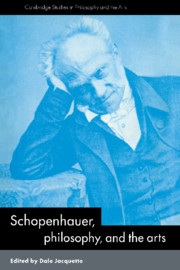Book contents
- Frontmatter
- Contents
- List of contributors
- Editor's acknowledgments
- List of abbreviations
- 1 Schopenhauer's metaphysics of appearance and Will in the philosophy of art
- PART I The work of art: Schopenhauer on the nature of artistic creation
- PART II The experience of beauty: Schopenhauer's theory of aesthetic encounter
- PART III Schopenhauer's enduring influence on the arts: idealism and romanticism
- 9 Schopenhauer on music as the embodiment of Will
- 10 Schopenhauer and the musicians: an inquiry into the sounds of silence and the limits of philosophizing about music
- 11 Metaphysics and aesthetics: a case study of Schopenhauer and Thomas Hardy
- 12 Schopenhauer according to the Symbolists: the philosophical roots of late nineteenth-century French aesthetic theory
- 13 Schopenhauer's philosophy of architecture
- Bibliography of selected sources on Schopenhauer's aesthetics
- Index
10 - Schopenhauer and the musicians: an inquiry into the sounds of silence and the limits of philosophizing about music
Published online by Cambridge University Press: 05 May 2010
- Frontmatter
- Contents
- List of contributors
- Editor's acknowledgments
- List of abbreviations
- 1 Schopenhauer's metaphysics of appearance and Will in the philosophy of art
- PART I The work of art: Schopenhauer on the nature of artistic creation
- PART II The experience of beauty: Schopenhauer's theory of aesthetic encounter
- PART III Schopenhauer's enduring influence on the arts: idealism and romanticism
- 9 Schopenhauer on music as the embodiment of Will
- 10 Schopenhauer and the musicians: an inquiry into the sounds of silence and the limits of philosophizing about music
- 11 Metaphysics and aesthetics: a case study of Schopenhauer and Thomas Hardy
- 12 Schopenhauer according to the Symbolists: the philosophical roots of late nineteenth-century French aesthetic theory
- 13 Schopenhauer's philosophy of architecture
- Bibliography of selected sources on Schopenhauer's aesthetics
- Index
Summary
“ … the rest is silence”
(Shakespeare)“Science has laid bare to us the organism of speech; but what she showed us was a defunct organism, which only the poet's utmost want can bring to life again; and that by healing up the wounds with which the anatomic scalpel has gashed the body of speech and by breathing into it the breath that may animate it with living motion. This breath, however, is – music.”
(Richard Wagner)INTRODUCTION
Schopenhauer did not write very much about music. His musical remarks take up surprisingly little space in his otherwise lengthy, but classically pellucid, philosophical corpus. Even granting that the remarks are intended only to make sense as part of a total metaphysical system, they are, critics have found, frustratingly incomplete. Nevertheless, no philosopher's writings about music have proved more influential. Exploited, as Thomas Mann thought, by “enthusiastic admirers and fanatical converts,” Schopenhauer was not wrong in believing that musiciankind would learn something from him it would never forget. Almost the mere mention of his name has come to stand for an entire worldview about the status, meaning, and value of classical music. He articulated what modern commentators sometimes call “the Idea of Music.” Deservedly or not, he has become to musical aesthetics what Beethoven has become to classical music itself – a central reference point in a range of historically momentous debates. That Schopenhauer was largely responsible for providing the rationale behind the canonization of Beethoven only renders this comparison more fitting.
- Type
- Chapter
- Information
- Schopenhauer, Philosophy and the Arts , pp. 200 - 228Publisher: Cambridge University PressPrint publication year: 1996
- 8
- Cited by



